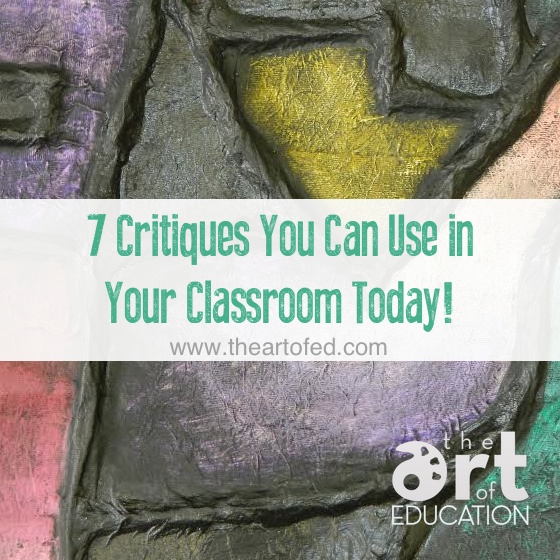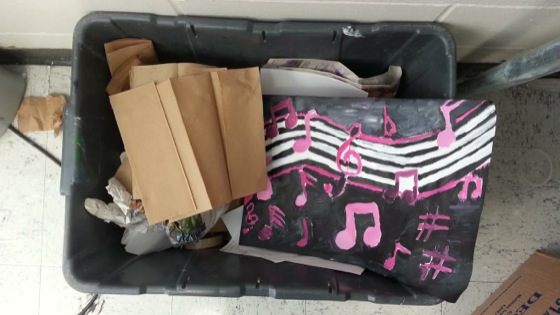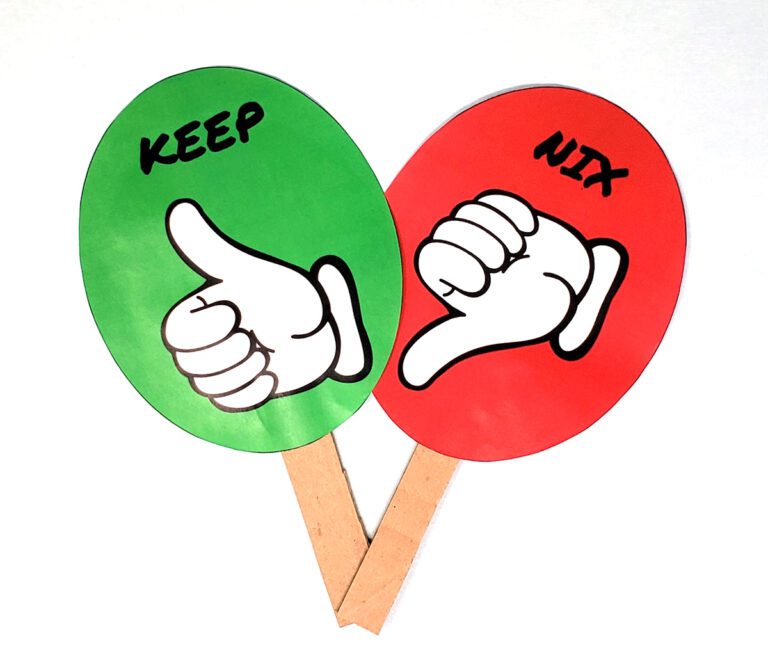Conducting critiques is an important part of teaching art. Critiques teach higher-order thinking skills, get students to interact with one another and help students receive authentic feedback from both their peers and their teachers. However, if you are going to do multiple critiques throughout the year, you need to move beyond simply holding a discussion with a nervous room full of kids that don’t want to be called on and don’t want to talk. Here are a few strategies to get kids interested, get them comfortable, and get them talking.
1. The Sandwich Critique
A LOT of teachers use this type of critique, and if you don’t, you should get on board! My sandwich consists of bread (compliment), meat (constructive criticism), and more bread (another compliment.) This gives us a positive start and positive end to our comments, but still allows for some suggestions for improvement. Many people add extra “ingredients” to their sandwich, (asking questions, making other connections outside of art, etc.) but I like to keep it simple, which is a perfect template for introducing my Intro and Level 1 classes to critiques.
2. Reduce, Reuse, Recycle
When summer projects come back, we usually have a few good, a few bad, and a few in between. Same with figure drawings at the beginning of the year. So when we do our critiques, we focus on projects that are less than successful. I like to have my kids Reduce, Reuse, and Recycle. Reduce means they take off a part that’s not working. Maybe the composition is better with a couple of inches cut off the paper, or perhaps a certain part needs to be erased–just taking a little part away to make the piece better.
Reuse means that even though the piece itself isn’t as strong as we’d like, certain aspects (composition, color, ideas, subjects) should be revisited in a future artwork. We’re reusing those aspects we think could be turned into something worthwhile. Lastly, Recycle is nothing more than taking the worst project directly to the recycling bin. Kids usually are more than happy to get rid of the work that isn’t successful. It can be cathartic for them to get rid of something that has caused so much frustration.
These ideas are all great ways to get your students engaged with the critique process. If you have a particularly tough crowd or are wanting even more in-depth information, be sure to check out the Critiques at Every Level PRO Pack. You can find this Pack in PRO Learning. You’ll learn how to use critiques to enhance learning through a natural progression and discover how to encourage students to reflect on their artmaking for increased engagement.
3. Keep it Positive
This is a great critique for the beginning of the year. Kids are usually pretty apprehensive about the critique itself, and some kids are deathly afraid of anything bad being said about their artwork. We simply make a rule that we’re voicing opinions without any negativity. It may seem counterintuitive to have a critique without criticism, but a relaxed atmosphere can go a long way when students are still getting to know each other and aren’t yet comfortable with the critique process.
4. Super Secret Surprise Sticky Notes
I give each of my AP Studio Art students a pile of sticky notes. They run around the room and leave comments for younger students. Just little comments about what they like about the work that is hanging in the room. We don’t tell anyone about them, so when the kids get their art back after it has been taken down, there’s a little surprise and some positivity for them–an authentic assessment from an audience they didn’t even know was paying attention. And if it’s signed by one of the resident 12th-grade art superstars, so much the better!
5. Olympic Judging
It’s kind of a fun change to let kids judge artwork as if they were Olympic diving or figure skating judges. I give them dry-erase boards (or blank paper) with a marker, then when a student holds up his or her work, everyone else gives it a score from 1 to 10. Students judging the work with a high score can talk about what they like, and those with low scores can discuss what they would like to see improved. Everyone is participating, and it’s easy to get kids talking if you just ask them to explain the reasoning behind their scores.
6. Individual
One thing I’ve tried to do more every year is in-depth individual critiques with my students. While the rest of the class is working, I like to pull kids aside to talk specifically about their finished work. We talk through the grading process together; I can see their reasoning and motivation for doing what they did, and they can hear my rationale as I determine their grades. The one-on-one situation allows kids to be open and honest in ways they may not be able to do in front of the entire class. As a teacher, it gives me an excellent opportunity to interact closely with my students in a meaningful way.
7. Ranking Artworks in Various Categories
Whether you want to reinforce ideas on your rubric or revisit criteria specific to an assignment, this type of critique is a great way to look again at specific elements or details in students’ work. It works like this: the teacher asks for works with a specific criteria, like an excellent use of detail, good use of color, interesting line work, or whatever else seems appropriate. The teacher then holds up two pieces of student work, and the kids vote for the better of the two. The process repeats with other artworks and continues until there is a clear winner. The process can be repeated with as many different categories as you’d like. If you’re feeling ambitious, you can make small paper awards and hang them next to the projects when they go up on the wall.
During this process, kids usually just want to vote by raising their hands, but if they want to comment and discuss, the floor is definitely open. This is a great critique for Intro classes because of the way it reinforces knowledge and allows kids to offer their opinions without forcing them to be the center of attention. It’s a great system for teachers because it’s possible to keep a class of 35 involved in a halfway decent critique for a significant amount of time.
So, there are seven ideas that you can take with you to make your critiques more engaging, more entertaining, and more successful. Get your kids thinking, and get your kids talking—it will make your art room a better place.
What types of critiques are successful in your classroom?
What other ways do you engage students in discussions about their work?
Magazine articles and podcasts are opinions of professional education contributors and do not necessarily represent the position of the Art of Education University (AOEU) or its academic offerings. Contributors use terms in the way they are most often talked about in the scope of their educational experiences.








